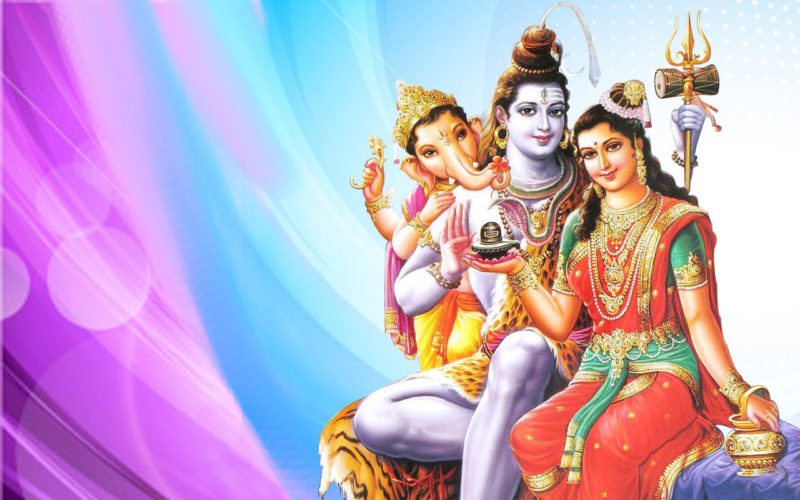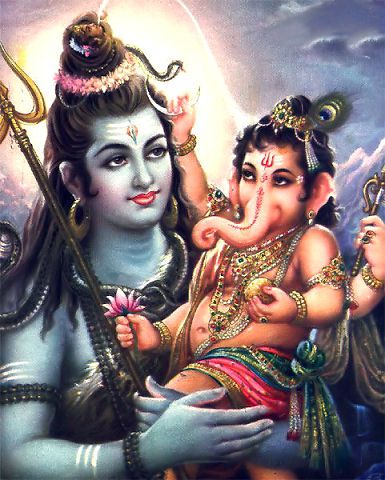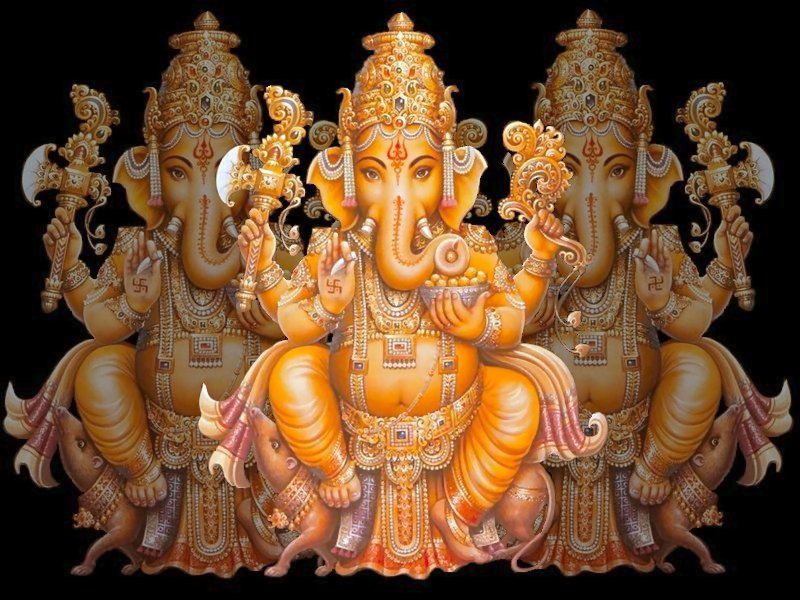No products in the cart.
Each Purana reports a different story to narrate the birth of Lord Ganesha. Some legends tell that he was born from the Shiva spirit (manasa putra); others, in fact most of them describe (Vaamana-Purana, Matsya-Purana, Skanda-Purana), Ganesha as the creation of Parvati.
According to the very well-known Shiva-Purana version, Lord Shiva’s wife, Parvati the Mountaineer, was disturbed once by her husband who entered the house, even though she was taking her bath.
The goddess felt annoyed, because she didn’t have any personal servant to guard her door. So, she rubbed her body skin and, with the perfumed unguents obtained, she molded the shape of a young boy, as glorious as daylight. Then, she granted him life and named him Ganesha, ordering that he should be on guard in front of her house.
When the child intended to impede the great god from entering the house, Shiva enraged, transformed himself in his Rudra form and attacked Ganesha. In the battle, Ganesha got his head cut off.
Ascertaining the incommensurable disaster striking her son, Parvati was inconsolable. Unable to find the child head, Shiva grafted an elephant head on the dead body and gave him life again. Trying to repair his big mistake, he recognized Ganesha as his son and empowered him on all his servants; so he became “Ganapati”.
Ganesha and Kubera
Kubera, the god of wealth, was very proud of his boundless fortune. One day, he organized a gorgeous dinner; among other famous guests, the divine couple, Shiva and Parvati, with their son Ganesha, were present.
The later, still a child, started to eat and he appeared quickly to be insatiable. Soon, the other guests found plates and dishes empty. Alas! Not satisfied with all the available food, Ganesha started to devour plates and dishes, the furniture and all the content of Alakâpuri, the main city of Kubera.
When he achieved to gulp down the whole, the child Ganesha threatened to swallow Kubera himself. Frightened, the god of wealth rushed forward to Shiva’s feet to request his help, since Ganesha’s appetite seemed to be unlimited.
The remedy was simple but spectacular: Shiva gave his son a handful of roasted cereal grains. Ganesha ate it and, wonderfully, his hunger stopped immediately.
This legend teaches us that a handful of common food, given with love, and eaten with devotion, is more important and more sustaining than the banquet offered by Kubera to impress the gods. From a different angle, this story shows that properties cannot bring peace and satisfaction to anybody. The only path to self-realization requires to burn our vasana. The destruction of the vasana is symbolized by the consumption of the grilled rice; indeed, when the rice has been cooked, he loses his germination capacity. Moreover, the seeds of our hidden desires lose strength and possibility to come back further.
Ganesha and Goddess Parvati
One day, the child Ganesha diverted himself in tormenting a cat, pulling his tail and rolling him on the ground. All of us know that children are able to injure animals but are not intentional in hurting them.
Just a moment after, he left the cat peaceful and went away. He even did not think about what he had done. He arrived at mount Kailash to meet his mother Parvati again. He found her badly suffering, covered with wounds and dust.
He asked her about what happened; she replied that he was responsible for this situation. Indeed, she had assumed the form of cat to play with her son Ganesha, the cat tormented by Ganesha.
This story teaches us that all the living beings are of divine essence. If we injure a living creature, one of our companions, human or animal, we injure God Himself.
Ganesha learned this lesson and we also must learn it during our lifetime.
The Wisdom of Ganesha

Shiva and Parvati used to play with their two sons, Ganesha and Kartikeya.
The gods had given them a marvelous fruit. Each boy wanted to get it for him alone.
Their parents explained to them that the nectar of the Supreme Knowledge and of Immortality was hidden in that fruit. To get the fruit, both had to compete. The winner should run three times around the world and come back first.
Kartikeya left at once. Riding his peacock, he flew in the sky, stopping at every sacred place on his way, praying and worshiping the gods.
Ganesha was fully aware of his stout body; it slackened off him badly. The rat, his vehicle, was rather slow and would not be able to beat Kartikeya.
But his wisdom suggested him the right solution. He went around his parents, Shiva and Parvati, showing deep devotion. When they asked him why he did not start his journey around the world, he replied:
“My parents Shiva and Shakti are the Whole Universe. In them is located the World. I do not need to go farther”.
Of course, he won the contest, and the fruit.
This legend emphasizes the importance of cleverness; Ganesha is a strong symbol of this quality which is always the best against force, speed or physical strength.
Ganesha, the Scribe
A very interesting story about Ganesha is the belief according to which he has been the writer of the Mahabharata.
The Sage Vyasa, the author of this epic, was meditating on Brahma. The god told him to request Ganesha to be the scribe for the dictation of this epic in verses.
Ganesha appeared immediately in the presence of Brahma and gave his agreement. However, he demanded that Vyasa should talk without any stop.
Vyasa dictated his own request: before starting to write, Ganesha had to understand each word, each thought, with all the significations they had.
Every time Vyasa observed that Ganesha had finished to write a verse (he used his broken tusk as a pen), he dictated another verse, as much complicated as possible. So, Ganesha was obliged to stop to write. That short period was enough to make Vyasa able to mentally compose the following verses and to tell them when Ganesha was ready.
This legend teaches us that the Mahabharata should not be read quickly. One must understand all the meanings of the story, and it is necessary to digest it. One must also listen to it carefully, and meditate about.
Actually, a belief says that the Mahabharata should not be read. We should listen to it every day, little by little. By this method, we may understand progressively the deep meaning of this story.
Ganesha and Lord Shiva
 One says that neither peace nor war action, nor daily business can succeed unless Ganesha has previously been worshiped.
One says that neither peace nor war action, nor daily business can succeed unless Ganesha has previously been worshiped.
This is not only true for human beings, but also for celestial creatures.
When Ganesha appeared, as the son born from Shiva’s mind, the later decided that Ganesha should be worshiped by anybody wishing to get success. Even worshiping other gods would be inefficient if prior worship to Ganesha is not made.
Thus, when Shiva left to fight the demons of the Tripura city, he forgot his own rule and rushed to the battle. However, when he embarked on his carriage, the wheel peg broke and the car was stopped.
Abashed that such an accident could happen to him, Shiva realized that he had forgotten to pray Ganesha before his departure, and this was the cause of the obstacle. Thus, he worshiped his son’s name and could proceed to the Tripuratanka battle which he won successfully.
The Broken Ganesha Tusk
Several legends explain how Ganesha broke his right tusk, which gives him the name of Ekadanta “The Lord who has only one tusk”.
The first legend (in the Brahmanda-aurana) is related to a battle between Ganesha and Parshuram. Parshuram was one of the Vishnu incarnations (avatar), born on earth to teach wisdom to the governing class, the Kshatriya, who had become arrogant and oppressed people. Bhagwan Parshuram meditated on Lord Shiva and got the divine axe, Parashu. This axe helped him to fight against all the corrupted princes, inspired by devils.
Deeply grateful to Shiva, he went to Mount Kailash to bow to his guru. But Ganesha, who was guarding the entrance of the palace, did not allow him to proceed. Ganesha told him to wait for the Shiva permission.
Parshuram thought: “I am a Shiva devotee, such a rule cannot be applied to me”.
Ganesha persisted to bar the way, Parshuram, usually peppery, struck violently the Ganesha tusk with his axe and broke it.
Then Shiva and Parvati arrived and blamed Parshuram who bowed down before Ganesha and supplicated to obtain his forgiveness and blessing. Then Ganesha was named Ekadanta “The Lord with one tusk”.
According to another legend, Ganesha broke himself his tusk during the battle against Gajamukhasura (the elephant-headed Asura). Taking the advice of Shukracharya, the Asura guru, this demon followed severe penances. Thus, he got unconquerable powers from Shiva. But he misused those powers to harass the gods who went to Ganesh and requested his help.
Ganesha did not hesitate to give a battle to this demon. During the fight, he understood that the demon could not be defeated, because of his particular powers. Then, Ganesha broke his right tusk and threw it to Gajamukhasura. He pursued him and converted him in a mouse. Then he rode this mouse, which he used as a mount, keeping it under control.






